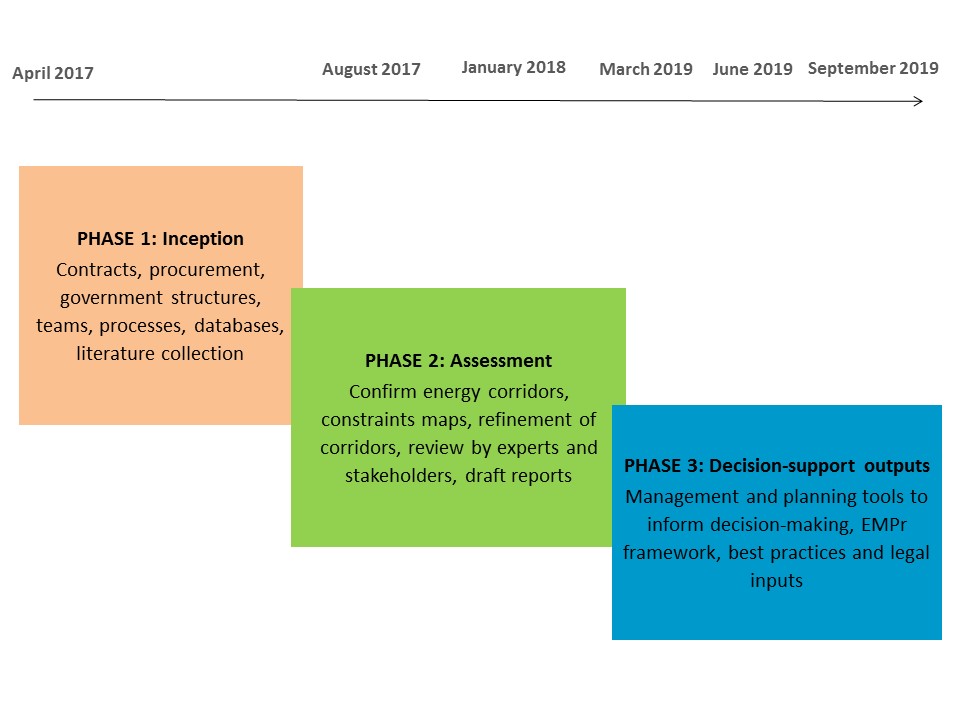Project Principles
The SEA is underpinned by three key principles, namely:
• Saliency: It must cover all the important issues and concerns;
• Legitimacy: It must be grounded in transparent and participatory processes; and
• Credibility: It must include groups of leading experts with rigorous scientific review structures implemented.
SEA integrates environmental and sustainability objectives into strategic decision-making, rather than focussing merely on the assessment of impacts. As such it is a pro-active decision support tool capable of shaping future development and its associated impacts. There are numerous potential benefits arising from the use of SEA, the nature of which may depend on how SEA is applied, its outcomes and its interactions with the decision-making process.
Project Phases

• Phase 1: Inception Phase
The primary purpose of this phase of the assessment is to set-up and implement all project management structures, convene the Expert reference group and Project Steering Committee, identify relevant stakeholders and recruit specialists. The Project Steering Committee (PSC) comprises authorities with a legislated decision-making mandate for gas pipeline development in SA. The Expert Reference Group (ERG) will provide assistance and technical know-how, provide insights with respect to the issues relevant to their sector and specifically challenge important issues relevant to the project. The members of the various groups will be available to the public on the website.
• Phase 2: Assessment Phase
This will be the component of the study where the actual assessment will be undertaken. At the end of Phase 2, Draft and Final SEA reports will be released for public review. This phase is separated into various tasks:
– Task I: Confirmation of initial energy corridors
– Task II: Environmental and engineering constraints mapping
– Task III: Energy corridor refinement
– Task IV: Specialists assessment and final energy corridors alignment
– Task V: Gazetting process
Task I (Confirmation of Corridors).Initial gas pipeline corridors have been identified as part of the Operation Phakisa report and the initial EGI expansion corridors have been provided by Eskom. The corridors that are to be assessed will be approximately 100 km wide and will link specific supply and demand areas. As part of the process to refine and confirm the initial gas pipeline corridors, a series of workshops will be held to gather information from major gas users and important business and government stakeholders. An initial outreach to the public will present the overall approach to the SEA and the initial corridors.
Task II (Constraints/Negative Mapping) will involve a wall to wall sensitivity delineation assessment to determine areas where the proposed linear infrastructures are likely to have a negative impact on these infrastructure (environmental constraints) and areas where the environment is likely to have a negative impact on gas pipeline infrastructure (engineering constraints). This mapping exercise will indicate areas to be avoided (Very High sensitivity), areas which are sensitive for various reasons (High-Medium sensitivity), and areas which demonstrate no sensitivity (Low sensitivity).
Task III (Corridor Refinement) will involve aggregating the digital information captured in Phases I and II to determine optimal placement of the corridors from both a ‘utilisation’ and ‘constraints’ perspective i.e. where utilization is maximized whilst ensuring suitable transmission routing alternatives are available from a constraints (both environmental and engineering) perspective. The outputs of this task were the Preliminary Energy Corridors and Draft Corridor Environmental Constraints Map.
Task IV of the study will involve specialist studies. Specialists will be required to review, validate and enhance the sensitivity delineations, for their particular specialist area of expertise, defined within the Draft Corridor Environmental Constraints Map. Specialists will also be required to recommend what additional information/ level of assessment should be undertaken within different sensitivity areas before gas pipeline or EGI development in these areas can be considered. Based on the inputs from the provincial, local municipal and stakeholder analysis and with input from the expert reference group and various sector specific institutions, the preliminary energy corridors will be adjusted and finalised for consideration by Cabinet. The results of this task will be used to inform the final sensitivity maps as well as the Standards or Norms and the Development Protocols.
Task V is the Gazetting process that will be managed by the DEA, with inputs from the project partners, once the SEA has been completed. The outputs of the SEA will be released for public comment through publication in the Government Gazette. The gazetting process is envisaged to take place in the second quarter of 2019.
• Phase 3: Decision-Making Framework Phase
This phase will translate the outputs from Phase 2 into environmental management measures and planning interventions for inclusion in the relevant legal environmental framework and local government planning tools, including Municipal Spatial Development Frameworks, to ensure that long term energy planning is secured. It will be undertaken by the Project Team (CSIR, SANBI) in close consultation with the various affected Departments.
